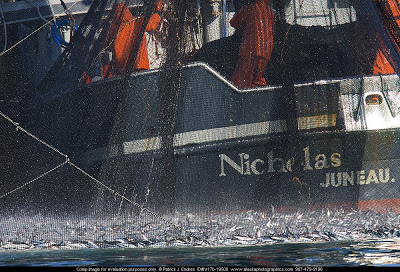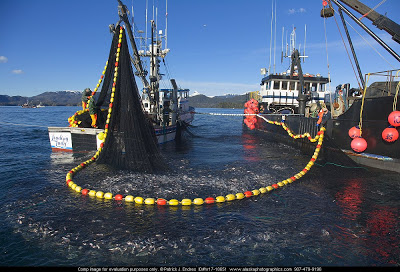Each year in March a brief Pacific herring sac roe commercial fishery happens in Sitka. The school of fish, which returns annually to the Sitka Sound, is monitored closely by the Alaska Department of Fish and Game. When the egg development reaches an optimal point, the season opens for a designated amount of time, targeting a specific tonnage of fish harvested by the fleet of fisherman. Purse seine fishing methods (the large net drawn in a circle around the school of fish) are used, however, the nets are not lifted on to the boat due the extremely large amount of captured fish. Instead, they are vacuumed from the net when drawn close to the side of the boat. It’s all about the eggs, not the meat. The eggs are sold primarily to an Asian market.
 Tons and tons of Herring are harvested for the sale of their eggs.
Tons and tons of Herring are harvested for the sale of their eggs.Canon 1Ds Mark II, 24-105mm f.40L IS
Photo details:
The exotic and somewhat tropical aqua color present in the water is the result of milky Herring sperm. It makes for quite a beautiful scene from the air. I spent one day on the water via a boat, and the next opener I took to the sky for some aerials. I was fortunate on this evening since the sun peaked through the clouds for about 3 minutes during the flight. During that time, I captured a handful of images. The bird’s eye view gives such a descriptive viewpoint, that I try often to get in the air whenever possible. Aerial photography can be complex. From scheduling, weather cooperation, finding the right aircraft, to communicating with the pilot for proper positioning. I’ve learned a few things that may be helpful if you are considering doing the same.
Considerations for aerial photography
- Take two cameras, each with a different lens
- Remove lens hoods unless absolutely necessary, they can be bad wind drags
- Use image stabilzed lenses
- Shoot with a high shutter speed (you are always at infinity focus anyway so the f stop-depth of field issue is not critical-at least you better be at infinity focus!)
- Have the aircraft door removed if possible (good luck with that since many pilots are reluctant to do it. You might consider giving them enough notice time to make proper FAA contacts for approval.)
- Keep from resting arms or elbows on the aircraft frame – it transfers vibrations to your camera
- If you have to shoot through a window (it is possible but not the best situation), wear dark clothes and watch for reflections. Do not let your lens touch the window, you won’t like it and your pilot won’t either.





